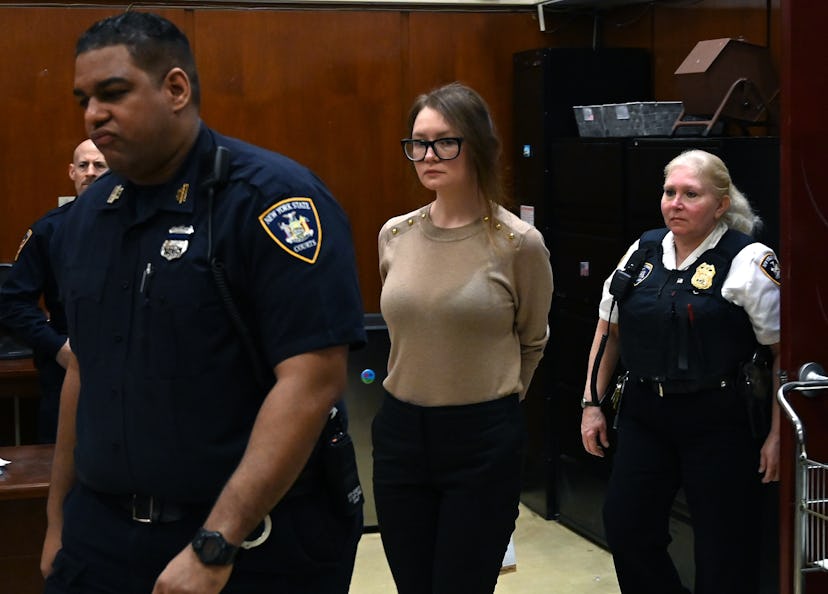Will We Ever Be Over Anna Delvey?

It’s been five months since Anna Delvey was sentenced to prison, not to mention nearly a year and a half since Jessica Pressler’s story detailing the full extent of Delvey’s misdeeds went viral. In usual pop culture terms, Delvey should be history. And yet, even as the infamous @AnnaDelveyCourtLooks Instagram account lays dormant, the fascination with Delvey persists. Just ask Cynthia Talmadge, a New York-based artist who unwittingly ended up beating out Netflix in providing the latest Delvey fix.
Midway through September, Talmadge opened an exhibition titled “Four Courtroom Outfits of Anna Delvey,” which will occupy Soft Opening’s gallery in London’s Piccadilly Circus Underground Station through late November. Tucked away in a dark corridor, the subterranean space bears zero resemblance to Delvey’s haunts in her era of luxury. And yet, thanks in large part to its title, the press above-ground hasn’t been able to get enough of it.
Installation view: Cynthia Talmadge, *Four Courtroom Outfits of Anna Delvey*, 2019, Soft Opening, London.
“Four Courtroom Outfits” is not an ode to Delvey’s “iconic” style, nor an artistic rendering of paparazzi photos taken while Delvey was being tried in Manhattan’s State Supreme Court. It does not even feature Delvey’s face, body, or now signature Céline glasses. And yet, Talmadge insists, it’s a portrait. Behind the storefront’s glass façade, and behind a dressing screen subtly painted with motifs like a matchbook referencing Delvey’s misadventures in Morocco, there’s a strange mechanism that, in a true feat of artistry and engineering, resembles Delvey’s ghost.
After replicating the titular courtroom outfits, Talmadge tied them to a utilitarian contraption that resembles a fan. Hidden behind the dressing screen, it creates the illusion that someone is throwing clothes around in an infinite loop, eternally undecided about what to wear. (Among the options: a white babydoll dress, a snakeskin print dress, a pair of pantyhose, and a standard-issue top that recalls Rikers Island, which served as Delvey’s home throughout the trial.)
“It’s like this eerie, almost human motion,” Talmadge said earlier this week, speaking from her studio in Brooklyn. “It almost feels like a séance—a conjuring of a spirit that’s larger than life.” It’s goofy and cartoonish, she added, but also a bit melancholy: “Even if there’s no one there to look at it, it never stops.”
Installation view: Cynthia Talmadge, *Four Courtroom Outfits of Anna Delvey*, 2019, Soft Opening, London.
Cynthia Talmadge, *Four Courtroom Outfits of Anna Delvey*, 2019.
Painstakingly as she recreated them, the ensembles remain almost entirely out of sight. And yet, a hint of Delvey was more than enough to spark the public and press’s appetite, perfectly illustrating the very phenomenon Talmadge was exploring: the media’s perverse fascination with, and superficial representation of, women accused of financial crimes. Before she knew it, though, it had taken on a life of its own: The media coverage of her show began to resemble the exact type of media coverage she was exploring, ignoring complexities such as how the installation fits into her practice in favor of soundbites from Talmadge about chokers and snakeskin print.
Oddly enough, for Talmadge, the show was never really about Delvey. In the months leading up to the show, she also toyed with the idea of Zsa Zsa Gabor, Dolly Parton, Lindsay Lohan, Anna Nicole Smith—any woman, really, who fits into the media’s canon of female con artists and scammers. “Anna Delvey was just a contemporary example,” Talmadge said. “It was more about the archetype. But making something about her is so larger than life.”
Perhaps rather begrudgingly, Talmadge has come to regard getting a taste of Delvey’s medicine with amusement: “It’s kind of a testament to the work,” she continued, pausing to laugh. “I don’t know—maybe it’s kind of great that I’m only being quoted saying things like ‘I think Anna’s probably like a real nightmare.'”